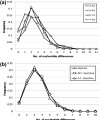Mitochondrial variation among the Aymara and the signatures of population expansion in the central Andes
- PMID: 24449040
- PMCID: PMC4289594
- DOI: 10.1002/ajhb.22507
Mitochondrial variation among the Aymara and the signatures of population expansion in the central Andes
Abstract
Objectives: The exploitation of marine resources and intensive agriculture led to a marked population increase early in central Andean prehistory. Constant historic and prehistoric population movements also characterize this region. These features undoubtedly affected regional genetic variation, but the exact nature of these effects remains uncertain.
Methods: Mitochondrial DNA (mtDNA) hypervariable region I sequence variation in 61 Aymara individuals from La Paz, Bolivia, was analyzed and compared to sequences from 47 other South American populations to test hypotheses of whether increased female effective population size and gene flow influenced the mtDNA variation among central Andean populations.
Results: The Aymara and Quechua were genetically diverse showing evidence of population expansion and large effective population size, and a demographic expansion model fits the mtDNA variation found among central Andean populations well. Estimated migration rates and the results of AMOVA and multidimensional scaling analysis suggest that female gene flow was also an important factor, influencing genetic variation among the central Andeans as well as lowland populations from western South America. mtDNA variation in south central Andes correlated better with geographic proximity than with language, and fit a population continuity model.
Conclusion: The mtDNA data suggests that the central Andeans experienced population expansion, most likely because of rapid demographic expansion after introduction of intensive agriculture, but roles of female gene flow need to be further explored.
Copyright © 2014 Wiley Periodicals, Inc.
Figures



Similar articles
-
Mitochondrial DNA diversity of the Amerindian populations living in the Andean Piedmont of Bolivia: Chimane, Moseten, Aymara and Quechua.Ann Hum Biol. 2007 Jan-Feb;34(1):34-55. doi: 10.1080/03014460601075819. Ann Hum Biol. 2007. PMID: 17536754
-
Population genetic structure of traditional populations in the Peruvian Central Andes and implications for South American population history.Hum Biol. 2014 Summer;86(3):147-65. doi: 10.13110/humanbiology.86.3.0147. Hum Biol. 2014. PMID: 25836744
-
The genetic history of indigenous populations of the Peruvian and Bolivian Altiplano: the legacy of the Uros.PLoS One. 2013 Sep 11;8(9):e73006. doi: 10.1371/journal.pone.0073006. eCollection 2013. PLoS One. 2013. PMID: 24039843 Free PMC article.
-
Major mitochondrial DNA haplotype heterogeneity in highland and lowland Amerindian populations from Bolivia.Hum Biol. 2001 Feb;73(1):1-16. doi: 10.1353/hub.2001.0001. Hum Biol. 2001. PMID: 11332638
-
Mitochondrial DNA and prehistoric settlements: native migrations on the western edge of North America.Hum Biol. 2004 Feb;76(1):55-75. doi: 10.1353/hub.2004.0019. Hum Biol. 2004. PMID: 15222680 Review.
Cited by
-
The peopling of South America and the trans-Andean gene flow of the first settlers.Genome Res. 2018 Jun;28(6):767-779. doi: 10.1101/gr.234674.118. Epub 2018 May 7. Genome Res. 2018. PMID: 29735605 Free PMC article.
-
Climate and demography drive 7000 years of dietary change in the Central Andes.Sci Rep. 2022 Feb 7;12(1):2026. doi: 10.1038/s41598-022-05774-y. Sci Rep. 2022. PMID: 35132100 Free PMC article.
-
The complete mitogenome of a 500-year-old Inca child mummy.Sci Rep. 2015 Nov 12;5:16462. doi: 10.1038/srep16462. Sci Rep. 2015. PMID: 26561991 Free PMC article.
References
-
- Albó X. Comments on “Lenguas y pueblos altiplánicos en torno al siglo XVI” by A. Torero. Revista Andina. 1987;5:375–376.
-
- Alva W. The royal tombs of Sipán: art and power in Moche society. In: Pillsbury J, editor. Moche art and archaeology in ancient Peru. Yale University Press; New Haven: 2001. pp. 223–245.
-
- Álvarez-Iglesias V, Jaime JC, Carracedo Á , Salas A. Coding region mitochondrial DNA SNPs: targeting East Asian and Native American haplogroups. Forensic Sci Int Genet. 2007;1:44–55. - PubMed
-
- Anderson A, Bankier AT, Barrell BG, de Bruijn MHL, Coulson AR, Drouin J, Eperon IC, Nierlich DP, Roe BA, Sanger F, Schreier PH, Smith AJH, Staden R, Young IG. Sequence and organization of the human mitochondrial genome. Nature. 1981;290:457–470. - PubMed
-
- Aris-Brosou S, Excoffier L. The impact of population expansion and mutation rate heterogeneity on DNA sequence polymorphism. Mol Biol Evol. 1996;13:494–504. - PubMed
Publication types
MeSH terms
Substances
Grants and funding
LinkOut - more resources
Full Text Sources
Other Literature Sources

